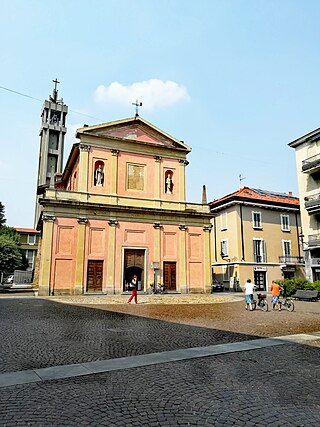
The Milan Metro is the rapid transit system serving Milan, Italy, operated by Azienda Trasporti Milanesi. The network consists of 5 lines with a total network length of 104.1 kilometres (64.7 mi), and a total of 113 stations, mostly underground. It has a daily ridership of about 1.4 million on weekdays. The Milan Metro is the largest system in Italy in terms of length, number of stations and ridership; and the seventh longest in the European Union.

Line 2, is a subway line serving Milan, Italy, operated by ATM as part of the Milan Metro. It is also called the Green Line,, as it is visually identified by green signs.

Line 3 is a subway line serving Milan, Italy. The line is part of the Milan Metro and is operated by ATM. Construction began in 1981 in order to be ready for the 1990 Football World Cup. It is also called the Yellow Line as it is identified by yellow signage.

Gabrio Piola was an Italian mathematician and physicist, member of the Lombardo Institute of Science, Letters and Arts. He studied in particular the mechanics of the continuous, linking his name to the tensors called Piola–Kirchhoff.

Cologno Monzese is a comune (municipality) in the Metropolitan City of Milan in the Italian region of Lombardy, located about 5 kilometres (3 mi) northeast of Milan. The population increased substantially after World War II, when many people from Southern Italy settled here.

The Teatro Lirico is a theatre in Milan, Italy. In the 19th and early 20th centuries it hosted numerous opera performances, including the world premieres of Donizetti's L'elisir d'amore and Giordano's Fedora. The theatre, located on Via Rastrelli, closed in 1998. However, a restoration project was begun in April 2007, and it has finally re-opened in December 2021 as the Teatro Lirico Giorgio Gaber. Stage Entertainment carried on the renovation of the Theatre, completing all finishes and all workings started by the administration "Comune di Milano".

The Museo Civico di Storia Naturale di Milano is a museum in Milan, Italy. It was founded in 1838 when naturalist Giuseppe de Cristoforis donated his collections to the city. Its first director was Giorgio Jan.

Line 1 is a Naples Metro line that runs from Piscinola Scampia in suburban north-west Naples to Garibaldi in southeast Naples. Printed in yellow on the map, it serves 19 stations, 16 of which are underground, over 18.8 kilometres (11.7 mi). It is operated by ANM. The line has been renamed Metrò dell'Arte reflecting the presence of contemporary art works installed in some of its stations.

Line 5 is an underground rapid transit line in Milan, Italy, part of the Milan Metro. The line, also known as M5 or the Lilac Line, is 12.8-kilometre (8.0 mi) long and goes through the city from the north to the north-west. It opened in stages between 2013 and 2015.

Porta Venezia is an underground station on Line 1 of the Milan Metro. It was opened on 1 November 1964 as part of the inaugural section of the Metro, between Sesto Marelli and Lotto.

The Stazione Sperimentale per le Industrie delle Essenze e dei Derivati dagli Agrumi (SSEA) is a special Agency of the Chamber of Commerce in Reggio Calabria.

Piola is a station of the Milan Metro, on line M2. The station grants direct access to the Politecnico di Milano (POLIMI).

Cascina Gobba is a station on Line 2 of the Milan Metro. The station is located on Via Padova at the west side of the A51 Milan bypass road. This is beside the major highway interchange known as Cascina Gobba, which is the main vehicular transportation hub of northeast Milan, Italy. The line branches here to terminate at either Cologno Nord or Gessate.

Luigi Berzano is an Italian sociologist and Catholic priest.

Cologno Sud is a suburban station on Line 2 of the Milan Metro in the municipality of Cologno Monzese.

Cologno Centro is a suburban station on Line 2 of the Milan Metro in the municipality of Cologno Monzese.

Vimodrone is a suburban station on Line 2 of the Milan Metro in the municipality of Vimodrone.

Cernusco sul Naviglio is a suburban station on Line 2 of the Milan Metro in the municipality of the same name.
The old farmhouses of Brugherio were agricultural structures typical of the Po-Valley in Lombardy, which gave its name to the surrounding areas as well, roughly corresponding to fractional towns in which Brugherio was divided. The union of the various small rural municipalities in which the territory was fragmented gave birth in 1866 to the municipality of Brugherio. Some are still visible: Bindellera, Casecca, Cattoni, Comolli, Dorderio, Guzzina, Increa, Modesta, Moia, Occhiate, Pareana, San Cristoforo, Sant'Ambrogio, San Paolo and Torazza.

Eugenio Soncini was an Italian architect.


















